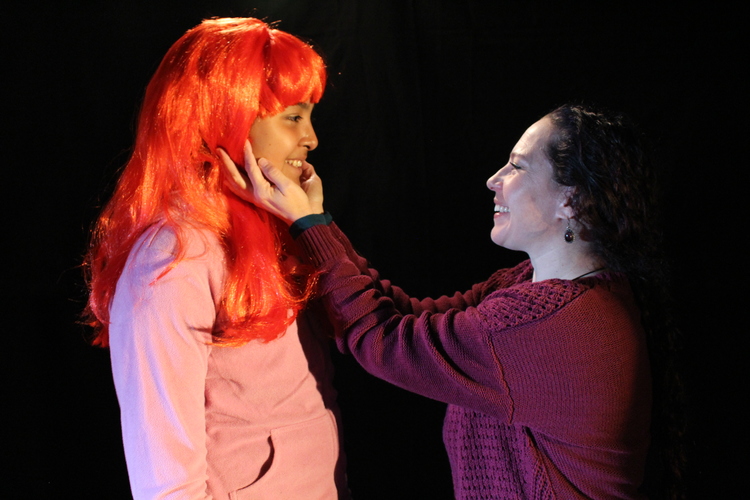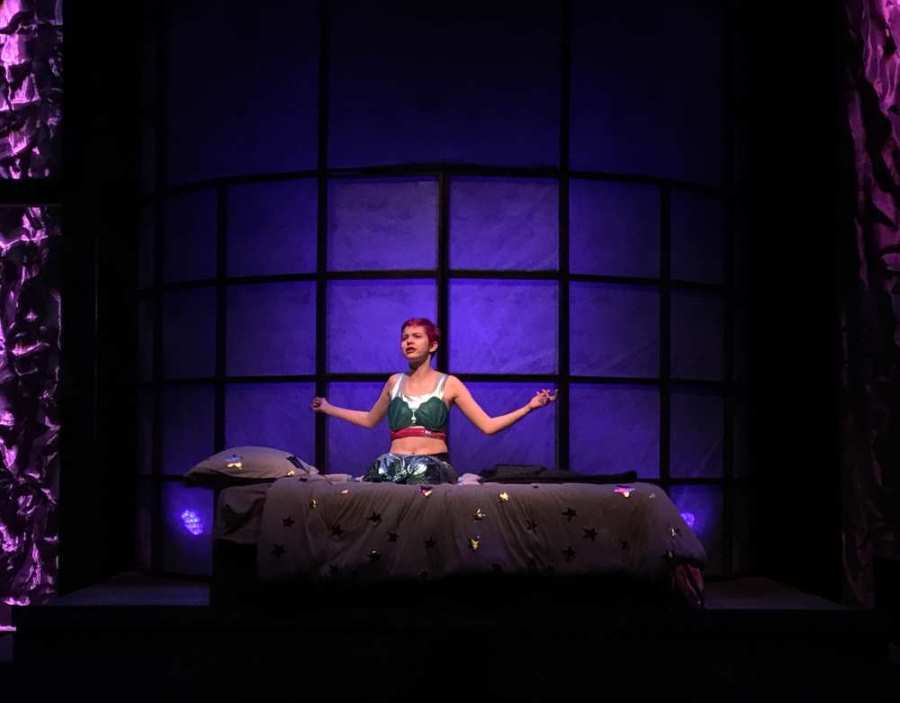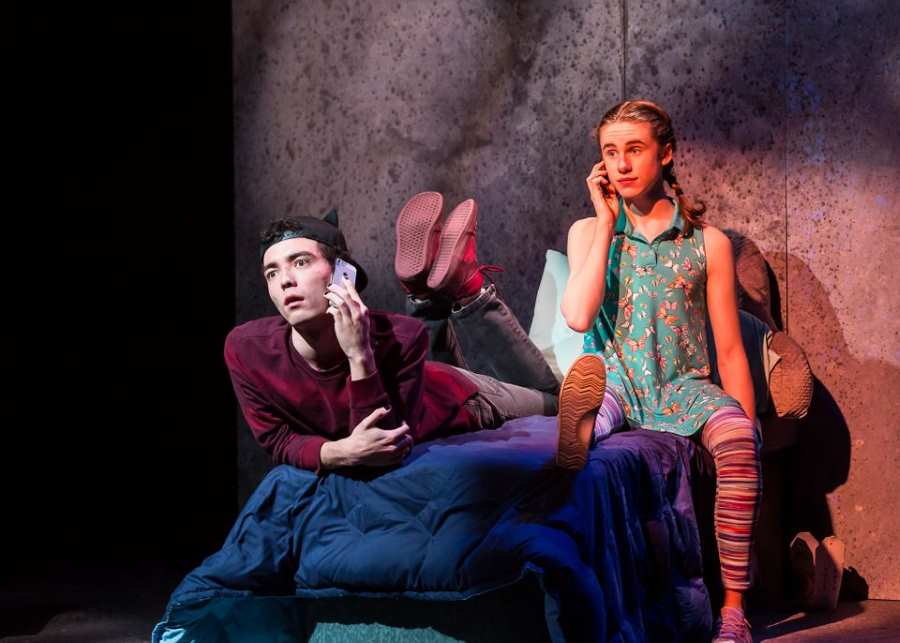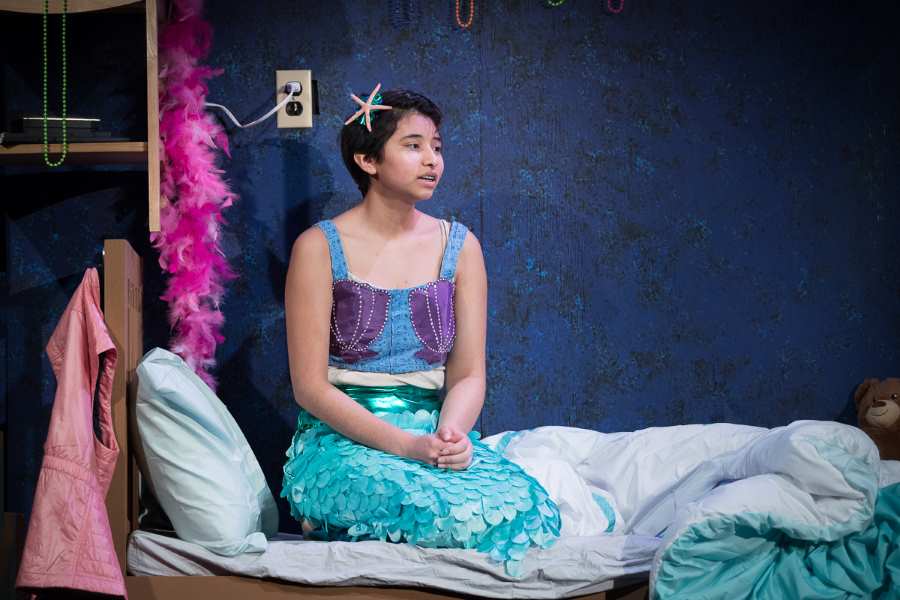“Gender-nonconformity and transgender identities are often reduced to stereotypes. It denies their complexities and humanity.”
The maturity of that insight belies the age of its speaker, 15-year-old Toni Reali. Reali is one of four young people who played trans tween Vi Bardisa-Nickerson this season in my play The Mermaid Hour, which follows Vi as she transitions from Victor to Violet, and traces her family’s varied reactions.
When I wrote the play, I stipulated in the casting breakdown that only teens who identify as gender-nonconforming (GNC) be considered for the role of Vi. For me, fighting erasure and misrepresentation with visibility and authenticity was paramount.
The National New Play Network facilitated the four productions of The Mermaid Hour as part of their Rolling World Premiere program. The theatres that produced the show this season—Borderlands Theater in Tucson, Ariz., Teatro Milagro in Portland, Ore., Mixed Blood Theatre in Minneapolis, and Actor’s Theatre of Charlotte in Charlotte, N.C.—all rose to the occasion. As Milagro’s producing creative director, Roy Arauz, put it, “The primary concern was always ensuring community members truly felt represented by the person chosen.”
Everyone involved knew they’d have to exceed their usual casting processes and forge new connections. Borderlands associate artistic director Milta Ortiz recounted reaching out to local LGBT groups, as well as a high school with a trans population. Actor’s Theatre of Charlotte executive director Chip Decker said, “We put everything we could think of out into the universe,” including connecting with a support group for parents of trans youth.
Even for Mixed Blood, which has featured trans/GNC artists for years, “the role of Vi stretched our moxie,” said artistic director Jack Reuler. But he was unperturbed, noting, “I love casting challenges.” They found a highly recommended trans actor for the role in a chamber musical version of the play titled Mermaid Hour: ReMixed, for which I wrote the book and lyrics and Eric Mayson wrote the music. Going even further, in that production, director Leah Anderson brought in trans/GNC artists for the design team and the band.
In each city, the end result was the hiring of a young actor who brought their own truth to the show. Variously identifying as trans, genderqueer, and non-binary, none of these young performers had ever worked with their respective theatres, and only one had done more than school plays. But inexperience was not a hindrance. For example, Borderlands added acting instruction outside of rehearsals.
The benefits are multifold: These young actors now have richer résumés, these theatres now have a wider pool of GNC performers on their radar, and their audiences have seen more of these lives depicted truthfully onstage. As Arauz said, “Being very deliberate and conscious in casting takes time, but the payoff is extraordinary.”
With supportive teams behind them, four very different young performers claimed their spotlights. I recently had a chance to speak with them as a group about the experience, and then they separately shared more thoughts via email. What follows is a condensation of our conversations.

DAVID VALDES GREENWOOD: What made you want to take on this role?
JAY GARCIA, 12, Borderlands: I knew I could be myself. After reading the script, I was like, this is so meant for me.
AZORALLA ARROYO CABALLERO, 17, Mixed Blood: Most movies/shows/plays give the perspective of the person who’s coming out. They show how hard life is, and how they have to live through unacceptance, but Mermaid Hour shows that is not always the case, that coming out can turn out differently for everybody. I really absolutely wanted to be a part of that!
JARYN LASENTIA, 15, Milagro: To represent a trans person is one of the most important things to me, because I can change people’s minds for the better. I hope I could make people understand what it feels like to experience Vi’s life, with all of its ups and downs.
TONI REALI, 15, Actor’s Theatre of Charlotte: Vi was the first transgender/genderqueer character I had seen, practically ever. Being able to play her sounded too good to be true. I jumped at the opportunity.
What were the challenges and rewards of playing a trans youth onstage?
REALI: Vi has so much confidence in every part of herself. As one of the characters says, “I’m not into easy definitions.” I’m more neither than either, so my gender doesn’t fit into a box even day to day. Vi’s confidence actually made me feel confident.
CABALLERO: Exactly. As a trans person but queer, coming to terms with myself, Vi inspired me to get out there and be more of myself.
LASENTIA: Seeing this little girl be so confident…I felt that through the story. And I was with people onstage that I really trusted, so I could go there. I liked going to that place every night.
GARCIA: I actually think it was harder for me to play 12-year-old Vi ’cause I’m still 12 years old. It was bittersweet kind of, because Vi and I are going through the same things.
REALI: It was differently bittersweet for me. I wish I had been like Vi—at 12, I was a mess.
GARCIA: Vi and I have a lot in common! First off, we both love mermaids. Second, we both have a gay best friend. Third, we’re stuck on our devices all the time. Transgender comes in last.

Speaking of friends, did your peers come to the show? How did they react to your performances? Was the response different for older audiences?
LASENTIA*: My friends saw it as pretty normal. They are sexually and gender diverse. Kids now are coming out earlier as so many different identities.
CABALLERO: At talkbacks, the kids of our generation could relate to everything; they didn’t need it explained. But for older people, there was a lot of “I didn’t quite get this…this wasn’t like life for us.” People kept saying, “This was a big learning experience for me.”
I’m sure you tapped into some of their misconceptions.
REALI: Some audience members made it a more complicated thing than it is. Vi has a crush on her friend Jacob, so someone asked me, “How does attraction work when you’re trans?” [This story earns laughter from from the group.] And I’m like, “Uh, the same way.”
CABALLERO: An older guy asked me if someone is born gay or becomes gay due to media.
REALI: How do you even answer that?
CABALLERO: People often confuse gender-nonconformity with sexuality; if you’re a butch female you’re automatically seen as a lesbian, and if you’re a feminine guy then you’re gay, which isn’t always the case.
GARCIA: People at my school would say I pretend to be a girl and I’m not. I’m just being me.

You’ve all said you plan to keep acting, so what parts would you like to see for yourself in the future?
LASENTIA: My dream role has not yet been written, but I’ll find it.
GARCIA: That’s easy! I want to play a mermaid!
CABALLERO: I’d like to play not the queer person or trans person but the supporting character, the one who gets it right and does the right thing by them.
REALI: I want a story like Vi’s, a real journey, for a non-binary character, [and] more representation of that. My dream role would be an openly genderqueer portrayal of Loki the Norse god.
David Valdes Greenwood is a playwright and the author of four books. A gay Cuban-American, he is interested in intersectional stories featuring LGBT and POC characters.
*A previous version of this story misattributed a quote to Jay Garcia, it was actually Jaryn Lasentia who said it.


